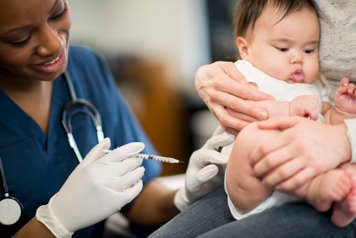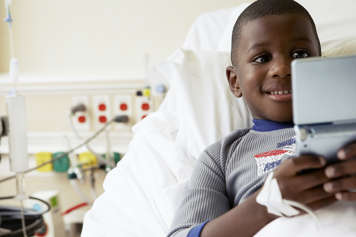
Positioning
Using age- and development-appropriate comfort positions can help your child relax and stay still during a painful procedure. To minimize your child’s anxiety, avoid laying them flat.
Infants (birth to 12 months)
Babies experience pain from procedures, so it is important to comfort them.
Comfort positions
Babies need to be comforted before the poke and continue to be cuddled and comforted afterwards.
- Cuddle a swaddled baby and keep them warm.
- Place your baby chest to chest (0–6 months) or back to chest (6–12 months).
Toddler/preschooler (1-5 years)
Comfort positions
- Have your child sit upright, back to chest, on a chair or bed.
- Hold your child during the procedure if it helps comfort them.
School age (6-12 years)
School-aged children need to feel in control. Give them age-appropriate information and choices and support them during the needle poke.
Comfort positions
School-aged children may or may not want to sit on your lap. Ask your child what is most comfortable for them.
- Sit your child upright, ideally, but let them choose which position is best for them.
- Hold your child or stay close by during the procedure.
- Praise and encourage your child.
- Use a comfort object such as a blanket or stuffed animal.
Teenagers (13-18 years)
Teenagers should receive information about the needle poke directly and be involved in developing their comfort plan.
Comfort positions
- Encourage your teen to sit upright, or in whatever position is best for them.
- Stay close by during the procedure, if your teen prefers.
- Give positive reinforcement and encouraging statements.
- Let your teen bring along a comfort object.

Distraction
Distraction works by shifting your child’s focus away from a needle poke or other similar procedure. Ask your health-care team how you can use the comfort kit items to provide age-appropriate distraction when needed.
Infants (birth to 12 months)
Babies experience pain from procedures, so it is important to distract them.
Distraction techniques
- Light-up or brightly-coloured toys
- Singing
- Baby’s favourite object
- Patting baby and using soothing voice during the procedure
- Pacifier
Toddler/preschooler (1-5 years)
Distraction techniques
- Light-up toys
- Pop-up picture books
- Drawing or colouring
- Bubbles
- Singing
- Music
- Favourite objects from home
School age (6-12 years)
School-aged children need to feel in control. Give them age-appropriate information and choices and support them during the needle poke.
Distraction techniques
Actively engage your child with one or more distractions. Offer several options to meet their needs.
- Books or magazines
- Videos
- Video games
- Drawing or colouring
- Deep breathing
- Singing
Teenagers (13-18 years)
Teenagers should receive information about the needle poke directly and be involved in developing their comfort plan.
Distraction techniques
Encourage your teen to choose a number of options to keep them distracted.
- iPad or other electronic devices
- Videos
- Video games or virtual reality headsets
- Deep breathing exercises
- Option to watch the procedure